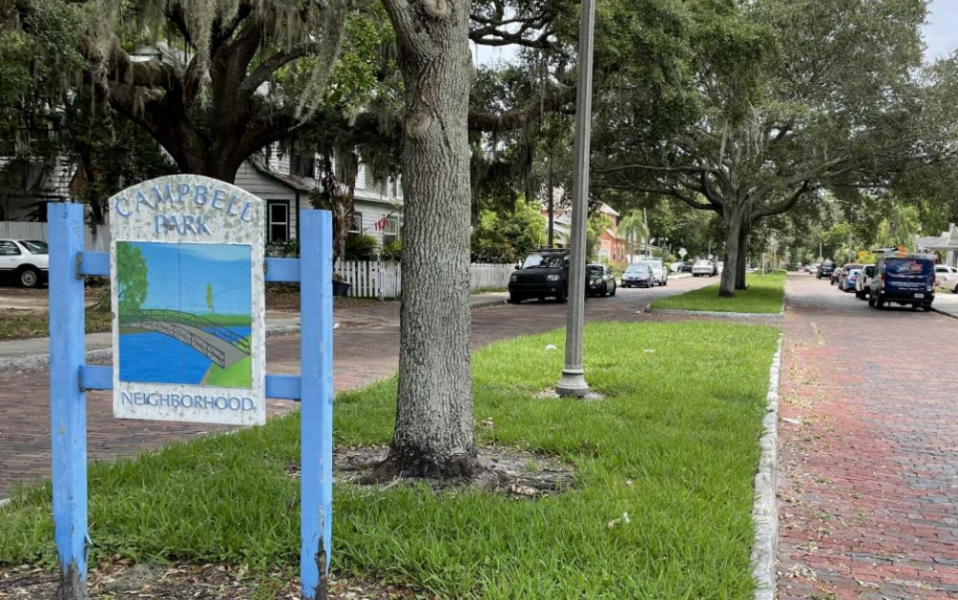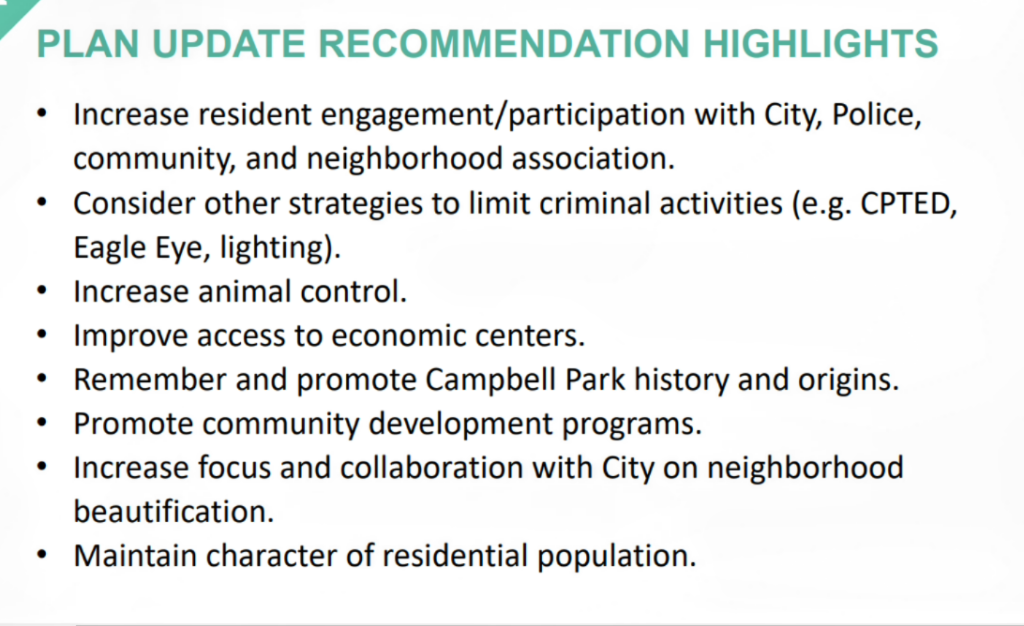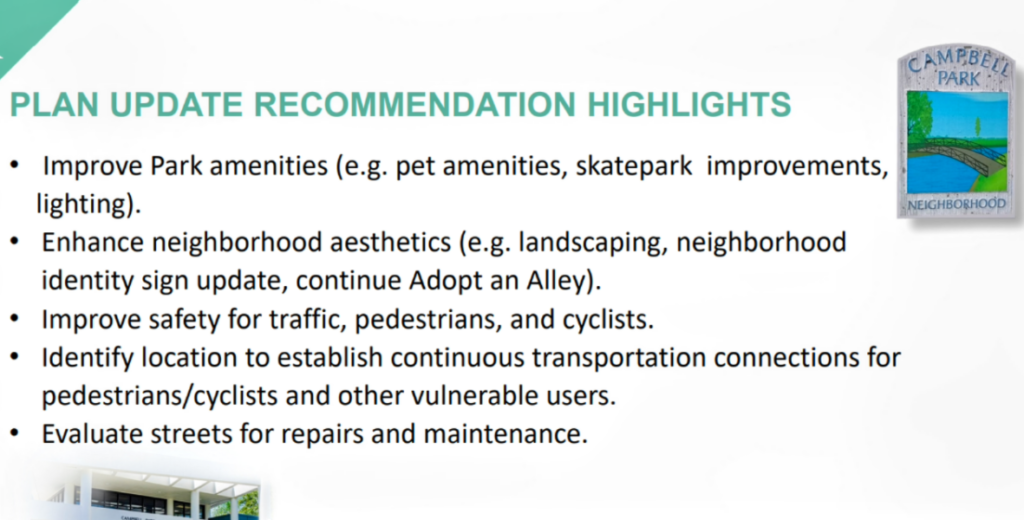Can official neighborhood plans curb gentrification?

St. Petersburg city council members recently heard how implementing neighborhood plans can increase community safety, spur economic development and even stem gentrification in predominantly Black neighborhoods, among many other benefits.
Local leadership began the official acceptance process of a neighborhood plan for the first time since 2009 at the Jan. 12 Housing, Land Use and Transportation Committee meeting. It is the first update to the Campbell Park initiative since 2004.
Like the rest of the city, the 98.6-acre midtown St. Petersburg neighborhood is undergoing significant changes. It will continue to do so due to its proximity to the Historic Gas Plant District/Tropicana Field redevelopment site.
Census statistics show that while African Americans still comprise 81% of Campbell Park’s population, their numbers have decreased in recent years.

A graphic showing Campbell Park’s changing demographics. Screengrab.
Meanwhile, the population of other races has soared from 89 in 2000 to 247 in 2022. Homeownership has increased from 38.8% to 57.3% in the same period, while the number of renters and vacant lots has decreased.
Councilmember Richie Floyd said Campbell Park’s total population seems to be stabilizing, and the demographics haven’t changed “too much.” However, he noted that St. Petersburg’s poorer residents, and “particularly, Black people,” are increasingly forced to move to more affordable areas.
“We lost seven percent of our African American population over the last decade,” added Floyd. “I know the goal is to have more owner-occupied homes – I think that needs to be done in a deliberative way.”
Susie Ajoc, community service director, led the extensive process to establish the plan. She said neighborhood participants were “an interesting mix,” and many longtime residents expressed their desire to protect Campbell Park’s character.
The neighborhood sits between 16th Street South and Dr. Martin Luther King Jr. St. to its east and west, respectively. It also runs north to south from 5th Avenue to 11th Avenue.

Campbell Park sits just a few blocks south of the Historic Gas Plant District/Tropicana Field redevelopment site. Screengrab.
Ajoc said Campbell Park has lost some housing units and noted its 46 vacant parcels. She relayed that residents are comfortable with increasing density along the corridors, which also needs improvement.
She also noted the area’s proximity to the Historic Gas Plant District and how that momentous redevelopment initiative will significantly impact Campbell Park. The neighborhood is just a few blocks south of Tropicana Field.
“They (residents) want to be able to understand – in terms of what is coming,” said Ajoc. “You know, kind of preparing for changes that will more than likely directly impact them as the Gas Plant area redevelops.”
Amy Foster, community and neighborhood affairs administrator, relayed that the homeowners she met during several tours of Campbell Park grew up in the area and moved away due to safety issues.
She believes those people are moving back now that there is a concerted effort to improve the community. “I think we might see some of those numbers change over time,” said Foster.

A graphic showing Campbell Park’s residents’ priorities. Screengrab.
In addition to people that grew up in the neighborhood now moving back, she told council members that people are often unaware that many homes lining Campbell Park’s streets are affordable.
“You would think that this is gentrification in some way,” added Foster. “But most of those programs are for homeowners under 120% AMI (area median income).”
Floyd said he heard similar stories while visiting the neighborhood.
Early results
Ajoc noted several benefits from a process that began in 2015 with the city’s Vision 2050 initiative. She said highlighting current land uses and potential zoning changes was an initial focus – and involving as many residents as possible was paramount to the plan’s success.
As such, program officials directly mailed 605 residents, placed door hangers in high-visibility areas, distributed yard signs and sent emails to neighborhood association members. Several meetings were held in person and virtually, and City Administrator Rob Gerdes credited Ajoc and her team’s work through the pandemic.
Beautification efforts are a priority for Childs Park residents, and Ajoc relayed their success.
Keep Pinellas Beautiful presented its top partnership award to the neighborhood association for its “Adopt an Alley” program. She said the group also received the preeminent state award from Keep Florida Beautiful for the initiative.
Council members expressed their astonishment that residents collected 12 tons of trash in the first year alone.

A graphic showing plan recommendations. Screengrab.
“Illegal dumping is a huge issue, not only in this neighborhood but in many of our neighborhoods in South St. Pete,” said Foster. “So, Suzie’s team has been spearheading an effort for multiple departments to work together to address that.”
That team has also identified sidewalks that need repair and procured funding, and that project is now underway. However, Ajoc noted the “real work” begins following the city council’s acceptance.
Committee members unanimously accepted the neighborhood plan. The item will go before the full city council for a final vote.

Additional plan recommendations. Screengrab.








Danny White
January 18, 2023at1:19 pm
What is happening with the Citrus Grove apartments redevelopment? It continues to appear to be substandard housing. The complex has a history of being a dangerous place to live or to be. There appears to have been tons of dollars thrown at the problem since 2011, and still the complex remains blighted… at least from the view from 16th Street S.
https://www.tampabay.com/news/humaninterest/buyer-of-crime-ridden-citrus-grove-apartments-vows-improvements/1232032/
https://www.businessobserverfl.com/news/2014/may/16/nonprofit-buys-citrus-grove-apartments/
https://www.abcactionnews.com/news/price-of-paradise/st-pete-leaders-put-another-4-million-towards-affordable-housing-advocates-say-it-doesnt-go-far-enough